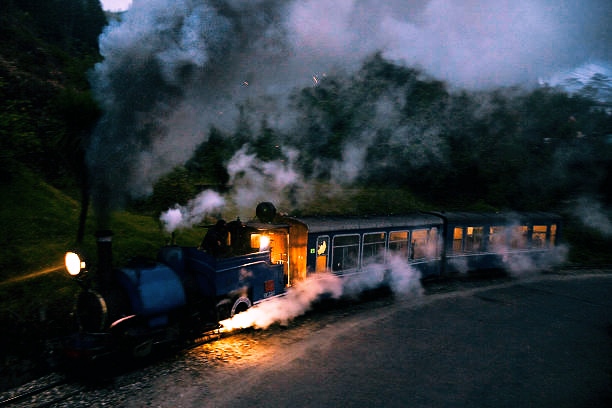
 HE is petite, yet powerful. Her elegance is outdone only by her endurance. Graceful in action, steadfast in spirit, subtle to the senses and attested by admiration, the winning ways of this “Iron Lady” at once enchants and emancipates the spellbound admirer.
HE is petite, yet powerful. Her elegance is outdone only by her endurance. Graceful in action, steadfast in spirit, subtle to the senses and attested by admiration, the winning ways of this “Iron Lady” at once enchants and emancipates the spellbound admirer.
A glimpse of her making her way against a steep gradient of the hilly terrain of Darjeeling becomes an entire lesson on perseverance. Again, when she cautiously cruises downhill, a lesson on the value of circumspection is immediately recognized. Neither is she a mere toy nor a mere train. Known affectionately as the ‘Toy Train’, she is the symbolic synergy of both and a precious part of the heritage that is the Darjeeling Himalayan Railway.
Established in 1881, the Darjeeling Himalayan Railway evolved during the British rule in India and owes its existence to Sir Franklin Prestage who headed its construction from 1879 to 1881. Initially designed to exploit the differential in the price of essential commodities between the hills and the plains, the DHR has come a long way in forging its distinct identity by chugging its way over different geographies, across different eras.
An engineering marvel of a different order, three loops and six Z-reversals adorn the thirteen stations of the DHR. At 7407 feet above the sea level, Ghum is the highest railway station in India. The DHR started with class A and class C locomotives. Class B locomotives were added in 1889 and the network was recognized as a UNESCO World Heritage site on 5th December 1999.
The DHR is indeed a world heritage, a fact testified by its various aspects – scientific, aesthetic, socio-economic and cultural.
Scientifically, DHR is an example of how a conventional technology can move forward by leaps and bounds when pushed to its limits. DHR completely transfigured the locomotive, which had thus far relied on adhesion technology alone, by making use of techniques such as loops and reverses to conquer the curves and tame the hilly terrain. Techniques such as these, coupled with the use of a narrow gauge and a short wheelbase effectively eliminated the use of heavy engineering works like tunnels and bridges. No wonder these scientific measures and devices have been credited for providing “the tangible contexts to the intangible cultural heritage of the DHR”.
Aesthetically, the sight of the “Toy Train” plodding its way across the face of the hills not only justifies but also embellishes its heritage status. When the two parallel arteries and veins of steel carried the pulse of a moving steam locomotive in a bygone era, the chugging of its engine had become the very heartbeat that sustained life on this part of the Eastern Himalayas. To this day, the sound of its whistle, like peals of laughter resonates the spirit of the Hills – ever ready to celebrate life. The visible streak of smoke from the steam engine curling skywards to mingle into the invisible air exhibits an evanescence, the aesthetics of which is simple yet sublime.
The significance of the DHR’s socio-economic value may be understood by the fact that its socio-economic worth was stated as one of the reasons by the UNESCO World Heritage Committee for the recognition of the DHR as a heritage – that the DHR illustrates, exceptionally and seminally, the process of how the development of railways in the 19th century had a profound influence on the social and economic developments on many parts of the world.
The historical and cultural significance of the DHR can be fathomed when one registers that it has its identity intrinsically attached to various cultures from two different continents, spanning three centuries. The picture of Darjeeling itself cannot be completed without the DHR featuring in it. Featured in numerous books, journals, magazines and movies, the DHR has very closely exported the image of Darjeeling in popular culture and collective imagination.
The Darjeeling Himalayan Railway is rightfully known as a ‘living heritage’, for it has outlived eras and yet remains fully functional with an incredible network of railway lines made of iron, steel and human ingenuity.
SOURCE
The Darjeeling Railway Station, located in the Darjeeling district of West Bengal, India.
